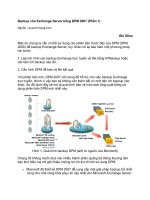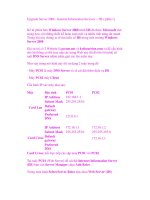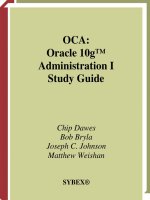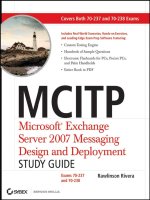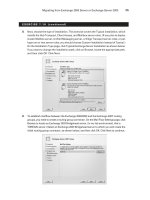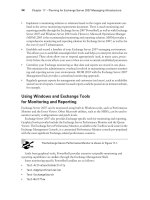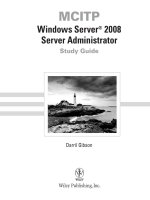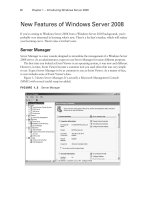MCITP Windows Server 2008 Server Administrator Study Guide phần 1 ppt
Bạn đang xem bản rút gọn của tài liệu. Xem và tải ngay bản đầy đủ của tài liệu tại đây (1.17 MB, 53 trang )
MCITP
Windows Server
®
2008
Server Administrator
Study Guide
Darril Gibson
93157ffirs.indd 3 8/11/08 12:53:07 PM
93157ffirs.indd 2 8/11/08 12:53:07 PM
MCITP
Windows Server
®
2008
Server Administrator
Study Guide
93157ffirs.indd 1 8/11/08 12:53:06 PM
93157ffirs.indd 2 8/11/08 12:53:07 PM
MCITP
Windows Server
®
2008
Server Administrator
Study Guide
Darril Gibson
93157ffirs.indd 3 8/11/08 12:53:07 PM
Acquisitions Editor: Jeff Kellum
Development Editor: Candace English
Technical Editor: Stuart Ami
Production Editor: Eric Charbonneau
Copy Editor: Kim Wimpsett
Production Manager: Tim Tate
Vice President and Executive Group Publisher: Richard Swadley
Vice President and Executive Publisher: Joseph B. Wikert
Vice President and Publisher: Neil Edde
Media Project Supervisor: Laura Moss
Media Development Specialist: Shawn Patrick
Media Quality Assurance: Josh Frank
Book Designer: Judy Fung
Compositor: Craig Woods, Happenstance Type-O-Rama
Proofreaders: Nancy Bell and Robert Shimonski
Indexer: Nancy Guenther
Cover Designer: Ryan Sneed
Copyright © 2008 by Wiley Publishing, Inc., Indianapolis, Indiana
Published simultaneously in Canada
ISBN: 978-0-470-29315-7
No part of this publication may be reproduced, stored in a retrieval system or transmitted in any form or by any
means, electronic, mechanical, photocopying, recording, scanning or otherwise, except as permitted under Sections
107 or 108 of the 1976 United States Copyright Act, without either the prior written permission of the Publisher, or
authorization through payment of the appropriate per-copy fee to the Copyright Clearance Center, 222 Rosewood
Drive, Danvers, MA 01923, (978) 750-8400, fax (978) 646-8600. Requests to the Publisher for permission should be
addressed to the Legal Department, Wiley Publishing, Inc., 10475 Crosspoint Blvd., Indianapolis, IN 46256, (317)
572-3447, fax (317) 572-4355, or online at />Limit of Liability/Disclaimer of Warranty: The publisher and the author make no representations or warranties with
respect to the accuracy or completeness of the contents of this work and specifically disclaim all warranties, including
without limitation warranties of fitness for a particular purpose. No warranty may be created or extended by sales or
promotional materials. The advice and strategies contained herein may not be suitable for every situation. This work
is sold with the understanding that the publisher is not engaged in rendering legal, accounting, or other professional
services. If professional assistance is required, the services of a competent professional person should be sought.
Neither the publisher nor the author shall be liable for damages arising herefrom. The fact that an organization or
Website is referred to in this work as a citation and/or a potential source of further information does not mean that
the author or the publisher endorses the information the organization or Website may provide or recommendations
it may make. Further, readers should be aware that Internet Websites listed in this work may have changed or disap-
peared between when this work was written and when it is read.
For general information on our other products and services or to obtain technical support, please contact
our Customer Care Department within the U.S. at (800) 762-2974, outside the U.S. at (317) 572-3993 or fax
(317) 572-4002.
Wiley also publishes its books in a variety of electronic formats. Some content that appears in print may not be
available in electronic books.
Library of Congress Cataloging-in-Publication Data:
Gibson, Darril.
MCITP : Windows server 2008 server administrator study guide (Exam 70-646) / Darril Gibson. — 1st ed.
p. cm.
ISBN 978-0-470-29315-7 (paper/cd-rom)
1. Electronic data processing personnel—Certification. 2. Microsoft software—Examinations—Study guides.
3. Microsoft Windows server. I. Title.
QA76.3.G5263 2008
005.4'476—dc22
2008027402
TRADEMARKS: Wiley, the Wiley logo, and the Sybex logo are trademarks or registered trademarks of John Wiley
& Sons, Inc. and/or its affiliates, in the United States and other countries, and may not be used without written per-
mission. Windows Server is a registered trademark of Microsoft Corporation in the United States and/or other coun-
tries. All other trademarks are the property of their respective owners. Wiley Publishing, Inc., is not associated with
any product or vendor mentioned in this book.
10 9 8 7 6 5 4 3 2
1
93157ffirs.indd 4 8/11/08 12:53:07 PM
Dear Reader,
Thank you for choosing MCITP: Windows Server 2008 Server Administrator Study
Guide (70-646). This book is part of a family of premium quality Sybex books, all written
by outstanding authors who combine practical experience with a gift for teaching.
Sybex was founded in 1976. More than thirty years later, we’re still committed to
producing consistently exceptional books. With each of our titles we’re working hard to
set a new standard for the industry. From the paper we print on, to the authors we work
with, our goal is to bring you the best books available.
I hope you see all that reflected in these pages. I’d be very interested to hear your com-
ments and get your feedback on how we’re doing. Feel free to let me know what you think
about this or any other Sybex book by sending me an email at , or if you
think you’ve found a technical error in this book, please visit .
Customer feedback is critical to our efforts at Sybex.
Best regards,
Neil Edde
Vice President and Publisher
Sybex, an Imprint of Wiley
93157ffirs.indd 5 8/11/08 12:53:08 PM
93157ffirs.indd 6 8/11/08 12:53:08 PM
To my loving wife of more than 16 years, who continues to provide me love
and encouragement even when I don’t deserve it.
93157ffirs.indd 7 8/11/08 12:53:08 PM
93157ffirs.indd 8 8/11/08 12:53:08 PM
Acknowledgments
No book is written alone. Instead, there is a wealth of people working behind the scenes to
help make a book the best possible. I’m grateful for the hard work put in behind the scenes
by several people. Stuart Ami, the technical editor; Candace English, the development editor;
Eric Charbonneau, the production editor; and Kim Wimpsett, the copy editor, all provided a
significant amount of work that helped produce this book. I’m grateful to each of them.
I’m also grateful to my agent, Carole McClendon, for helping open up so many oppor-
tunities for me, including this one, and to Jeff Kellum, the acquisitions editor, for having
the faith in me to take on this project.
93157ffirs.indd 9 8/11/08 12:53:08 PM
About the Author
Darril Gibson has been teaching Microsoft networking concepts since the NT 4.0 days
and has been teaching a myriad of other topics since many years before then. He’s been a
Microsoft Certified Trainer (MCT) since 1999 and holds many other certifications, includ-
ing MCSE (NT 4.0, 2000, 2003), MCDBA (SQL Server 7.0 and 2000), MCTS (Vista,
Server 2008 Active Directory, Server 2008 Applications Infrastructure, Server 2008 Net-
work Infrastructure and SQL Server 2005), MCITP (Server 2008 Server Administrator,
Vista Enterprise Support Technician, SQL Server 2005 Database Administrator and SQL
Server 2005 Database Developer), MCAD (.NET), and MCSD (VB 6, .NET).
Darril has developed several video training courses for KeyStone Learning Systems and
has written and co-authored several other technical books. He has a passion for teaching
and enjoys sharing knowledge in the classroom as much as he does through books.
He currently works full-time on a government contract providing a wide array of tech-
nical training to military and government personnel in support of a network operations
support center (NOSC). The NOSC supports over 100,000 users and provides a great envi-
ronment to see current technologies in action. He moonlights as an adjunct professor at a
local college (ECPI College of Technology) teaching system engineer courses.
Darril lives with his wife and two dogs in Virginia Beach, Virginia, but on most weekends
they can be found playing on about 24 acres of land in Halifax County. He’s been learning
the power of water as he’s tried to create a pond on this land. He’s found that configuring
networks is a piece of cake compared to building a good pond, but he hasn’t given up yet.
93157ffirs.indd 10 8/11/08 12:53:08 PM
Contents at a Glance
Introduction xxi
Assessment Test xxxii
Chapter
1 Introducing Windows Server 2008 1
Chapter
2 Planning Server Deployments 43
Chapter
3 Using Windows Server 2008 Management Tools 95
Chapter
4 Monitoring and Maintaining Network Infrastructure Servers 157
Chapter
5 Monitoring and Maintaining Active Directory 207
Chapter
6 Monitoring and Maintaining Print and File Servers 275
Chapter
7 Planning Terminal Services Servers 333
Chapter
8 Planning Windows Server 2008 Security 369
Chapter
9 Planning Business Continuity and High Availability 413
Appendix
About the Companion CD 449
Glossary 453
Index 467
93157ffirs.indd 11 8/11/08 12:53:08 PM
93157ffirs.indd 12 8/11/08 12:53:08 PM
Contents
Introduction xxi
Assessment Test xxxii
Chapter
1 Introducing Windows Server 2008 1
Windows Server 2008 Editions 2
Key Benefits of Windows Server 2008 5
IIS 7 and the .NET Framework 5
Virtualization 6
Security 8
Interaction with Vista 9
New Features of Windows Server 2008 10
Server Manager 10
Server Core 12
PowerShell 12
Windows Deployment Services 13
New Functionality in Terminal Services 14
Network Access Protection 15
Read-Only Domain Controllers 15
Improvements in Failover Clustering 16
Installing Windows Server 2008 18
Hardware Requirements 18
Running Windows Server 2008 on Your System 18
Using Virtual PC 2007 19
Activating Windows Server 2008 24
Review of Active Directory 25
Active Directory Elements 26
Promoting a Server to a Domain Controller 29
Active Directory Domain Services Tools 33
Summary 34
Exam Essentials 35
Review Questions 36
Answers to Review Questions 40
Chapter
2 Planning Server Deployments 43
Introducing Windows Deployment Services 44
The Big Picture of WDS 45
WDS Requirements 49
WDSUtil 50
Installing Windows Deployment Services 52
Creating a Standard Server Image 57
Configuring Windows Deployment Services 61
93157book.indd 13 8/7/08 3:51:20 PM
xiv
Contents
Deploying a Computer Image 65
Multicast Transmissions 68
Introducing Server Core 70
Managing Server Core Remotely 72
Server Core Registry Editor 75
Creating a Rollback Plan 78
Creating Backups 79
Enabling Another Server 80
Utilizing Virtualization 80
Virtual Server Uses 82
Virtual Server Licensing 85
Summary 85
Exam Essentials 86
Review Questions 87
Answers to Review Questions 92
Chapter
3 Using Windows Server 2008 Management Tools 95
Server-Monitoring Tools 96
Reliability and Performance Monitor 97
Event Viewer 111
Windows System Resource Manager 123
Remote Management 125
Accessing the Desktop Remotely 125
Remote Desktop Connection 128
Remote Desktops 130
Remote Server Administration Tools 132
Server Core 133
Using Terminal Services Gateway Servers 133
Windows Server Update Services 134
WSUS Prerequisites 137
Downloading and Deploying Updates 137
WSUS in a Distributed Environment 138
Configuring Clients 138
WSUS 3.0 Remote Management 145
System Center Configuration Manager 145
Summary 147
Exam Essentials 148
Review Questions 149
Answers to Review Questions 154
Chapter
4 Monitoring and Maintaining Network
Infrastructure Servers 157
Dynamic Host Configuration Protocol 159
Overview 159
Scopes 163
93157book.indd 14 8/7/08 3:51:20 PM
Contents
xv
Ports Used by DHCP 168
Options 169
Windows Deployment Services Interaction 170
DHCP Management 171
Domain Name System 171
Names 172
Zones 175
Dynamic Update 187
DNS and RODCs 189
Windows Internet Naming Service 191
WINS Is a Feature 192
DNS and WINS 192
Network Access Protection 192
VPN Enforcement 195
IPSec Enforcement 196
802.1x Enforcement 196
DHCP Enforcement 197
Summary 198
Exam Essentials 199
Review Questions 200
Answers to Review Questions 204
Chapter
5 Monitoring and Maintaining Active Directory 207
Active Directory Roles 208
Active Directory Domain Services 209
Read-Only Domain Controller 213
Active Directory Certificate Services 217
Types of Certification Authorities 221
Active Directory Lightweight Directory Services 224
Active Directory Rights Management Services 224
Active Directory Federation Services 225
Active Directory Rights and Permissions 225
Active Directory Backup and Recovery 230
Windows Server 2008 Backup 231
Backing Up Active Directory 232
Restoring Active Directory 235
Group Policy 240
Understanding How Group Policy Is Applied 242
When Group Policy Is Applied 247
Loopback Processing 248
Group Policy Management Console 249
Exploring a Few Specific Group Policy Settings 257
Language Specific Administrative Templates 264
93157book.indd 15 8/7/08 3:51:20 PM
xvi
Contents
Summary 264
Exam Essentials 264
Review Questions 266
Answers to Review Questions 271
Chapter
6 Monitoring and Maintaining Print and
File Servers 275
File Servers 276
File Server Resource Manager 277
Shares 281
Permissions 286
Offline Data Access 292
Disk Quotas 297
Indexing and Searching 302
Print Servers 303
Understanding Shared Printers 304
The Print Process 305
Installing a Printer 306
Printer Pooling 308
Printer Publishing 308
Distributed File System 310
Using DFS Namespaces to Organize Content 311
DFS Replication 313
Domain-Based vs. Stand-Alone Namespaces 316
Replication Topology 317
Creating a DFS Replication Group 318
SharePoint Services 322
Application Pools 323
SharePoint and WSRM 323
Summary 323
Exam Essentials 324
Review Questions 325
Answers to Review Questions 330
Chapter
7 Planning Terminal Services Servers 333
Terminal Services Servers 334
Terminal Services Role 336
TS RemoteApp 343
Terminal Services Gateway 346
Terminal Services Session Broker 350
Terminal Services Web Access 351
Terminal Services Licensing 352
93157book.indd 16 8/7/08 3:51:20 PM
Contents
xvii
Internet Information Services 354
IIS and ASP.NET 355
IIS and the Windows Process Activation Service 356
IIS and WSRM 356
URL Authorization Rules 356
Installing IIS 357
Ports Used by IIS 358
Summary 359
Exam Essentials 359
Review Questions 361
Answers to Review Questions 366
Chapter
8 Planning Windows Server 2008 Security 369
Disk-Level Security with BitLocker 370
BitLocker Requirements 371
Adding the BitLocker Feature 371
Configuring the Partitions 373
Enabling BitLocker on Non-TPM Systems 376
Starting a System with BitLocker 377
Multifactor Authentication with BitLocker 377
BitLocker Recovery 378
Encrypting File System 378
EFS and BitLocker 379
Encrypting Files and Folders 379
EFS Certificates and Keys 380
Recovering EFS-Encrypted Files 382
Auditing for Server Security 387
Auditing Detailed Active Directory Events 388
Enabling Directory Service Access Auditing 389
Enabling Object Access 391
Network Security 392
Firewalls 392
Remote Access 397
Network Policy and Access Services 400
RADIUS 401
Network Encryption with IPSec 402
Summary 403
Exam Essentials 404
Review Questions 405
Answers to Review Questions 410
93157book.indd 17 8/7/08 3:51:21 PM
xviii
Contents
Chapter
9 Planning Business Continuity and
High Availability 413
Shadow Copies 414
Disks 418
RAID Configurations 418
Disk Storage Solutions 421
Failover Clustering 424
Requirements 425
Nodes and Quorums 426
Network Load Balancing 428
Requirements 430
NLB and Server Core Installation 431
Windows Server Backup Features 431
Backup Locations 433
Wbadmin 433
Using Windows Server Backup 435
Windows Recovery Environment 436
Entering WinRE 437
Summary 439
Exam Essentials 439
Review Questions 441
Answers to Review Questions 446
Appendix
About the Companion CD 449
What You’ll Find on the CD 450
Sybex Test Engine 450
PDF of the Book 450
Adobe Reader 450
Electronic Flashcards 451
System Requirements 451
Using the CD 451
Troubleshooting 451
Customer Care 452
Glossary 453
Index 467
93157book.indd 18 8/7/08 3:51:21 PM
Table of Exercises
Exercise
1. 1 Installing Virtual PC 2007 20
Exercise
1.2 Installing Windows Server 2008 22
Exercise
1.3 Adding the Active Directory Domain Services Role 31
Exercise
1.4 Installing Active Directory Domain Services 32
Exercise
2.1 Installing Windows Deployment Services 52
Exercise
2.2 Configuring Windows Deployment Services 53
Exercise
2.3 Adding Image Groups and Images to WDS 56
Exercise
2.4 Creating and Capturing a Custom Image 59
Exercise
2.5 Changing Permissions for Image Groups 62
Exercise
2.6 Deploying an Image 67
Exercise
3.1 Configuring Your System to Remotely Monitor a Server Using
Reliability Monitor 102
Exercise
3.2 Running a Data Collector Set 104
Exercise
3.3 Creating a Data Collector Set from a Template 106
Exercise
3.4 Configuring Subscriptions 115
Exercise
3.5 Configuring an Event Task to Respond to an Event 119
Exercise
3.6 Configuring a WSUS GPO 141
Exercise
4.1 Installing DHCP . . . . . . . . . . . . . . . . . . . . . . . . . . . . . . . . . . . . . . . . . . . . . . . 161
Exercise
4.2 Creating a DHCP Scope 165
Exercise
4.3 Modifying a DHCP Scope 167
Exercise
4.4 Creating a Forward Lookup Zone 184
Exercise
4.5 Creating Records within a Forward Lookup Zone 184
Exercise
5.1 Delegating Control to an OU 211
Exercise
5.2 Adding the Backup Feature 231
Exercise
5.3 Backing Up Critical Volumes 233
Exercise
5.4 Nonauthoritatively Restoring Active Directory 239
Exercise
5.5 Creating and Linking GPOs in the GPMC 250
Exercise
5.6 Delegating Permissions on a GPO 254
Exercise
5.7 Adding a User to the Group Policy Creator Owners Group 256
Exercise
5.8 Backing Up and Restoring GPOs 263
Exercise
6.1 Installing the File Services Role 277
Exercise
6.2 Creating a Share with the Provision Share Wizard 281
93157flast.indd 19 8/11/08 12:56:34 PM
xx
Table of Exercises
Exercise
6.3 Creating Shares with Computer Management and
Windows Explorer 282
Exercise
6.4 Enabling Offline Files 294
Exercise
6.5 Enabling Quotas 298
Exercise
6.6 Add the Print Services Role and Install a Printer 307
Exercise
6.7 Replicating Data with DFS 318
Exercise
7.1 Installing the Terminal Services Role 339
Exercise
7.2 Installing a RemoteApp Program 343
Exercise
7.3 Installing the IIS Role 357
Exercise
8.1 Adding the BitLocker Feature 372
Exercise
8.2 Configuring Partitions for BitLocker 374
Exercise
8.3 Enabling BitLocker on Non-TPM Systems 376
Exercise
8.4 Exporting Your EFS Certificate 382
Exercise
8.5 Importing Your EFS Certificate 384
Exercise
8.6 Adding the Network Policy and Access Services Role 400
Exercise
9.1 Enabling Shadow Copies 415
Exercise
9.2 Running Windows Server Backup 435
Exercise
9.3 Launching WinRE 437
93157flast.indd 20 8/11/08 12:56:35 PM
Introduction
Microsoft has recently changed its certification program to contain three primary series:
Technology, Professional, and Architect. The Technology Series of certifications are
intended to allow candidates to target specific technologies and are the basis for obtaining
the Professional Series and Architect Series of certifications. The certifications contained
within the Technology Series consist of one to three exams, focus on a specific technol-
ogy, and do not include job-role skills. By contrast, the Professional Series of certifications
focus on a job role and are not necessarily focused on a single technology but rather a
comprehensive set of skills for performing the job role being tested. The Architect Series of
certifications offered by Microsoft are premier certifications that consist of passing a review
board consisting of previously certified architects. To apply for the Architect Series of certi-
fications, you must have a minimum of 10 years of industry experience.
When obtaining a Technology Series certification, you are recognized as a Microsoft
Certified Technology Specialist (MCTS) on the specific technology or technologies that
you have been tested on. The Professional Series certifications include Microsoft Certified
IT Professional (MCITP) and Microsoft Certified Professional Developer (MCPD). Passing
the review board for an Architect Series certification will allow you to become a Microsoft
Certified Architect (MCA).
This book has been developed to give you the critical skills and knowledge you need to
prepare for the PRO: Windows Server 2008 Server Administrator exam (exam 70-646).
The Microsoft Certified Professional Program
Since the inception of its certification program, Microsoft has certified more than 2 million
people. As the computer network industry continues to increase in both size and complexity,
this number is sure to grow—and the need for proven ability will also increase. Certifications
can help companies verify the skills of prospective employees and contractors.
Microsoft has developed its Microsoft Certified Professional (MCP) program to give
you credentials that verify your ability to work with Microsoft products effectively and
professionally. Several levels of certification are available based on specific suites of exams.
Microsoft has recently created a new generation of certification programs:
Microsoft Certified Technology Specialist (MCTS) The MCTS can be considered the
entry-level certification for the new generation of Microsoft certifications. The MCTS cer-
tification program targets specific technologies instead of specific job roles. You must take
and pass one to three exams.
Microsoft Certified IT Professional (MCITP) The MCITP certification is a Professional
Series certification that tests network and systems administrators on job roles, rather than
only on a specific technology. The MCITP generally consists of passing one to three exams,
in addition to obtaining an MCTS-level certification.
93157flast.indd 21 8/11/08 12:56:35 PM
xxii
Introduction
Microsoft Certified Master The Microsoft Certified Master certification is a step above
the Professional Series certification and is currently offered for Windows Server 2008, SQL
Server 2008, and Exchange Server 2007. Qualified MCITPs attend advanced training specific
to the certification track, must successfully complete in-class written and lab exams, and then
complete a separate qualification lab exam.
Microsoft Certified Professional Developer (MCPD) The MCPD certification is a Profes-
sional Series certification for application developers. Similar to the MCITP, the MCPD is
focused on a job role rather than on a single technology. The MCPD generally consists of
passing one to three exams, in addition to obtaining an MCTS-level certification.
Microsoft Certified Architect (MCA) The MCA is Microsoft’s premier certification series.
Obtaining the MCA requires a minimum of 10 years of experience and requires the candidate
to pass a review board consisting of peer architects.
How Do You Become Certified as a Windows Server 2008
Server Administrator?
Attaining a Microsoft certification has always been a challenge. In the past, students have
been able to acquire detailed exam information—even most of the exam questions—from
online “brain dumps” and third-party “cram” books or software products. For the new
generation of exams, this is simply not the case.
Microsoft has taken strong steps to protect the security and integrity of its new certifi-
cation tracks. Now prospective candidates must complete a course of study that develops
detailed knowledge about a wide range of topics. It supplies them with the true skills needed,
derived from working with the technology being tested.
The new generations of Microsoft certification programs are heavily weighted toward
hands-on skills and experience. It is recommended that candidates have troubleshooting
skills acquired through hands-on experience and working knowledge.
Fortunately, if you are willing to dedicate the time and effort to learn Windows Server
2008 Active Directory, you can prepare yourself well for the exam by using the proper
tools. By working through this book, you can successfully meet the exam requirements to
pass the Windows Server 2008 Active Directory exam.
This book is part of a complete series of Microsoft certification study guides, published
by Sybex Inc., that together cover the new MCTS, MCITP, and MCPD exams, as well as
the core MCSA and MCSE operating system requirements. Please visit the Sybex website at
www.sybex.com for complete program and product details.
MCITP Requirements
Candidates for MCITP Server Administrator certification on Windows Server 2008 must
pass three Windows Server 2008 exams: 70-640 (Windows Server 2008 Active Directory
Configuration), 70-642 (Windows Server 2008 Network Infrastructure Configuration),
and 70-646 (Windows Server 2008 Server Administrator). For a more detailed description
of the Microsoft certification programs, including a list of all the exams, visit the Microsoft
Learning website at
www.microsoft.com/learning/mcp.
93157flast.indd 22 8/11/08 12:56:35 PM
Introduction
xxiii
The Windows Server 2008 Server Administrator Exam
The Windows Server 2008 Server Administrator exam covers concepts and skills related to
planning, configuring, troubleshooting, and managing Windows Server 2008 servers.
Microsoft provides exam objectives to give you a general overview of pos-
sible areas of coverage on the Microsoft exams. Keep in mind, however,
that exam objectives are subject to change at any time without prior notice
and at Microsoft’s sole discretion. Please visit the Microsoft Learning web-
site (
www.microsoft.com/learning/mcp) for the most current listing of
exam objectives.
Types of Exam Questions
In an effort to both refine the testing process and protect the quality of its certifications,
Microsoft has focused its newer certification exams on real experience and hands-on profi-
ciency. There is a greater emphasis on your past working environments and responsibilities and
less emphasis on how well you can memorize. In fact, Microsoft says that certification candi-
dates should have hands-on experience before attempting to pass any certification exams.
Microsoft will accomplish its goal of protecting the exams’ integrity by
regularly adding and removing exam questions, limiting the number of
questions that any individual sees in a beta exam, limiting the number
of questions delivered to an individual by using adaptive testing, and
adding new exam elements.
Exam questions may be in a variety of formats: depending on which exam you take,
you’ll see multiple-choice questions, as well as select-and-place and prioritize-a-list ques-
tions. Simulations and case study–based formats are included as well. You may also find
yourself taking what’s called an adaptive format exam. Let’s take a look at the types of
exam questions and examine the adaptive testing technique, so you’ll be prepared for all
the possibilities.
With the release of Windows 2000, Microsoft stopped providing a detailed
score breakdown. This is mostly because of the various and complex ques-
tion formats. Previously, each question focused on one objective. Recent
exams, such as the Windows Server 2008 Active Directory exam, however,
contain questions that may be tied to one or more objectives from one or
more objective sets. Therefore, grading by objective is almost impossible.
Also, Microsoft no longer offers a score. Now you will be told only whether
you pass or fail.
93157flast.indd 23 8/11/08 12:56:36 PM
